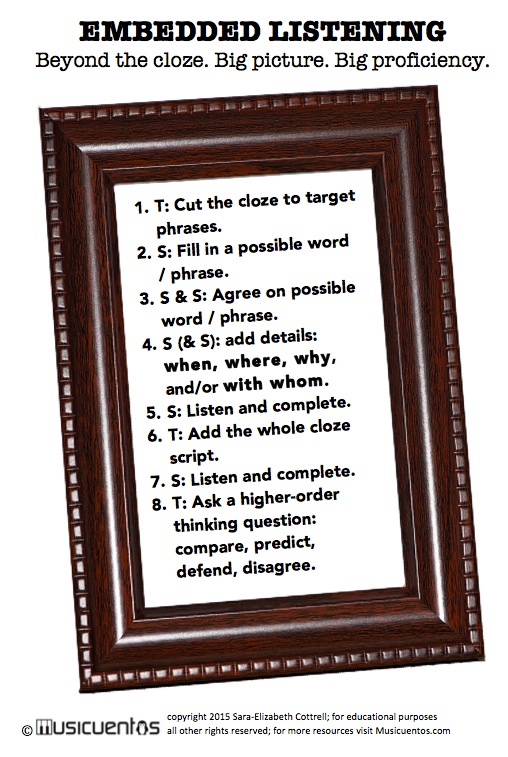Are you subscribed to the CASLS weekly newsletter? If not, go here and sign up now, then come back. Every Monday you’ll get quick resources and bite-size, research-packed learning delivered to your inbox.
One such week a listening activity caught my eye. The activity was adapted from an activity on Lanternworld (ESL) and with it, CASLS was encouraging us to go beyond the common cloze activity in which “students are not often encouraged to engage in a metacognitive approach to task completion.” As I looked at the way they adapted the cloze activity (asking students to predict what goes in the blank, talking about predictions with a peer), I was reminded of the strategy for teaching with comprehensible input of embedded reading, in which students are given sheltered texts that get gradually more complex as students work with them.
Then it hit me – what if we took the principles of embedded reading and created embedded listening? I’m sure you’ve done aspects of this type of scaffolding with yours students before, but in case it hadn’t occurred to you, as it hadn’t occurred to me, let me help you with a couple of resources.
First, here’s an explanation of the process I’m calling “embedded listening.”
Process
- First, to begin scaffolding the authentic audio, shorten the script to short, key phrases specifically aligned with what you are targeting by using the audio source. Drop the key word and present the cloze as only these key phrases.
- Next, students make predictions: what word do they think will fill the blank effectively? You could switch it up and ask them to be funny with it (but in a way that makes sense).
- After making their solo predictions, students pair up and come to an agreement on what they think the word might be.
- Now it’s time for a pure proficiency exercise: adding detail. I loved hearing a presenter (wish I could remember who it was!) talk about how she would ask students to count on their hands how many details they could add: “I like to eat (one finger- action) lots of hamburgers (two – added object) at a restaurant near my house (three – where) with my friends (four – with whom) because they’re the best hamburgers (five – why). Look at all that detail and complexity that pushes students beyond the simple phrases we so often hear!
- Here, students hear the script for the first time – but just the simple phrases, and from you. You say the phrases once, they write what they hear.
- Now give them the whole script. Feel free to drop more words than what you gave them the first time around, according to what you think their ability and frustration level will be. Choose whether you will play the audio only twice or three times, or if you’ll let them listen as many times as they want.
- At the end, ask for higher order thinking, regardless of the level. Can they compare something to their own culture? Express an opinion? Relate their own experience?
 Intermediate embedded listening: past narration, sports context
Intermediate embedded listening: past narration, sports context
I’ll be putting these embedded listening resources out from time to time here on the blog in the resources section as well as on my Teachers Pay Teachers store. This first set of activities is based on a commercial using a lot of past narration in a sports context and is for intermediate students, targeting past narration (preterite / imperfect contrast). Five pages with a key and six activities, including ideas for extension. Designed to last at least one 50-minute class period, longer if you choose one or more of the extension activities.
4 Comments
Comments are closed.





Thank you for the Musicuentos “bump” for our free email digest, InterCom! Here’s the link to the original activity, written by Larry Vandergrift, a leading expert in listening and language learning: http://caslsintercom.uoregon.edu/content/18795. I love your adaptation and focus on higher-order thinking skills!
Thanks for that link, Lindsay. I was disappointed in myself that I hadn’t saved it to post in the beginning, only the source website! Hope to see you again soon.
This is a great idea, since it’s so hard to teach listening, being a skill that is only gained through practice! This practices the strategies of listening as well as the listening itself. Gracias!
[…] You can even use the same resource several times. In my Russian journey, I do this with songs, but I’m motivated so I don’t need to change up the activity; I really can’t get enough of the same song. However, teachers often successfully change activities on the same resource (see: “How I use Textivate” from @welangley) or the concept of embedded reading or my own embedded listening. […]